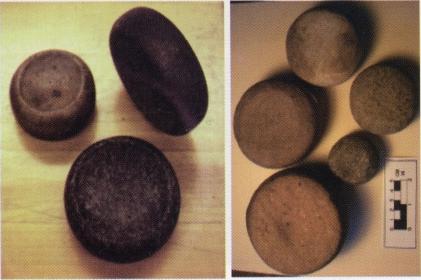by E. J. Neiburger, Waukegan, Illinois
Originally Published in the Central States Archaeological Journal, Vol.57, No.4, pg.188

George Catlin painting of Mandan Indians playing Chunke in 1832, showing the game reached into historic times.
The ancient Mississippians were a complex society sharing many traditions of the Meso-Americans and Southwest Indian groups. The Mississippians could be characterized as living in a theocracy. Individuals and groups would go through various kinds of rituals and ceremonies every day. There was a seamless belief between the physical and supernatural worlds of the present and the past.
The Mississippians believed in a layered cosmos with a celestial “above world,” a “middle world” where everyday life occurred, and a “subterranean world” that lay under the earth and waters. Everyday games and other activities had an intense spiritual as well as temporal impact that stresses this belief.
One of the more popular games the Mississippians played was Chunke (Chunkey). In this game a chunkey stone, in the shape of a 2 to 6 inch diameter discoidal (Figures 1-2) was rolled over the bare ground or ice while several players threw spears in an attempt to mark where the stone would stop rolling. The closest spear to the final location of the stone, without actually hitting the stone, determined the winner. Extensive audience participation including wild gambling, singing and spiritual “guidance” made this an observer as well as athlete sport. The game continued to be played into the historic period. DeSoto, in his visits of Mississippian settlements in the early 1500s, described this game which was played by many other tribes (e.g. Mandan, Hidatsa), even into modern times.
The Mississippians, like many of the other Indian groups, were cannibals. They, like their Meso-American (e.g.Maya, Aztec) and South Western (e.g. Anasazi) cousins went to war, captured prisoners, tortured them, scalped them and then ate them raw or cooked(Turner, 1999). In some cases, large numbers of individuals were consumed. This pastime, as horrible as it sounds, is evident from several sources. The first is the writings of DeSoto who visited Mississippian villages in the waning years of that culture. He reports of seeing the burning of prisoners and their scalps hung from spear poles being paraded through the villages.


Left: Discoidals from Wisconsin, Milwaukee Public Museum Right: Discoidals from Georgia/Tennessee
A second indication is the practices of the contemporary Meso-Americans and South Western Indians who were well documented cannibals. The Aztecs and Mayans killed thousands in an attempt to spill enough blood to please the gods. The Mississippians had similar customs, organization, religion and history. They did essentially everything the Meso-Americans did.
The third indication was the presence of many cannibalized skeletons in Mississippian village waste dumps (not cemeteries). These remains were comingled with the bones of other food animals and village garbage. For example, at Aztalan, Wisconsin, archaeologists unearthed a surprising number of scattered human bones discarded in refuse pits, fireplaces and in other garbage depots. The bones and bone fragments found there represented all parts of the skeleton and many showed clear signs of cutting, dismemberment, breaking and charring (cooking)(Figures 3-4). Many of these bones showed unique breakage so marrow and brain matter could be removed(Figure 5). There is considerable evidence of pot polished bones (the bone edges were broken and then smoothed by being stirred and rubbed against the side of a clay y cooking pot). (Figures 3-4). These remains have been found at Cahokia, Ramey, Aztalan and other Mississippian sites.”Used by Permission of the Author”
To learn more about or to join the Central States Archaeological Society, click here:CSASI.org
